“We live in an era where artists constantly have to self censor. In my experience more often to pander to a disingenuous idea of political correctness than to conservatism.”
MICHAEL SALU: In the world of photography, we often discuss the photograph as though the end object of the photograph, on the paper, in the frame, on the wall is far more important than the actual. The actual being the subject, the intention or the story of how that photograph came to be. I never see that disconnect in your work as you seem to be fully immersed and engaged in your environment, so I wanted to begin by asking about something close to home, the recent internal conflicts in South Africa. They were referred to in many of the press outlets I came across as ‘xenophobic’, a term I felt a little unsure about. I was keen to see if you had a point of view on this?
PIETER HUGO: Well a good place to start would be to say I am very saddened by it. It is a reiteration of the historical phenomena where working class blame other working class for their problems and not being able to see the wood for the trees, in that the government has essentially failed them. This comes back to the Mandela meta-narrative. More and more people are beginning to realise that maybe this idealised narrative we’ve been sold isn’t so rosy after all. There were incredible shortcomings within the deals that he brokered. Much of this unrest goes back to that. There is also another issue in that we have a country with 50% of the population unemployed and under employed and we have an unusually open door to refugees from the rest of Africa because of the ANC’s history and relationships with those countries and realistically we can’t sustain this influx of immigrants because of the strain it places on the bottom rung of the economic and social ladder.
MS: Naturally, I was suspicious of the way the headlines reduced this matter and also got me thinking a lot about the marginalisation of South Africans within South Africa and what is the actual experience of the working class in the country since the end of Apartheid?
PH: Most immigrants who come to South Africa are hard working. It is the Somalis that open the shops in the townships and a lot of this conflict is actually just opportunistic looting. Its real frustration and it is being articulated in really unacceptable ways.
MS: It also made me think about contrasting, but maybe in some ways comparable activity and what has been happening in Nigeria with Boko Haram and I wondered what you make of this conflict and its root causes? You’re a photographer whose movements have really intrigued me over the years, as you seem to traverse borders with your work. What do you understand of these pockets of reaction to maybe an ill-trusted status quo? Through your work and travels do you see any patterns that would allow for such groups to begin to form?
PH: I think if any pattern started to form is I just have a healthy distrust of any collective national paradigm. If you’ve seen your history rewritten and you don’t develop a healthy distrust of the national ‘story’ you’re supposed to buy into, well, you’re either incredibly naive!
Is your family from Nigeria?
MS: Yes, they are.
I was actually born in the UK, but did move to Nigeria at the age of 6 and was there for about 2 and a half years, while my mother worked in the Middle East during the 80s and was consequently able to build a home for my grandparents in Nigeria. We hopped around a little. I myself felt somewhat displaced having grown up British. That classic story, not feeling especially British but then also not really feeling Nigerian. As time goes on, one has been increasingly apprehensive about fully re-engaging with Nigeria, without feeling fraudulent. As we know it has been on rise economically and culturally for a while and within the art scene, there has been much talk about how ‘cool’ Lagos is. “Oh, you must go, it is so edgy and vibrant”. I’ve lived there and there is now a reluctance if I’m honest to wade into that moneyed art world. I know another Nigeria beyond its recent and often surface level affluence and I don’t want to feel opportunistic, only reaching to the country for those reasons alone. I do hope to be back soon but for much more personal reasons.
I think this is partly why over the years your work has really resonated with me and I was very keen to speak to you about it, as I recall reading somewhere about you saying that in a way you can’t claim to have an ‘authentic voice’ through the subject matter in your work. I found that interesting because I suppose you see yourself as an outsider in Africa, even though you are very much African?
PH: Yes, I’ll go off on a little tangent here, but Diane Arbus had created a list of requirements for what she felt was required to be a good artist. The one I remember well was that you have to isolate yourself, that you have to be an outsider. When I think about all the photographers, writers and artists that have inspired me, like David Goldblatt – South African man of Jewish descent that photographed Afrikaners – most of them are self-exiled or outsiders in some way. Being a part of this landscape really informs my work, this push between belonging and not-belonging. For example when I’m working in Nigeria and you ask someone if I’m African, they’ll tell you no, of course not. Yet my passport says I am. I guess for a long time that bothered me and now I take pride in that outsider position. Groucho Marx said “I don’t care to be a part of any club that will have me as a member”. It started in my teens working as a photographer during a turbulent time in South Africa’s history. I suppose initially with a kind of pure wanderlust and curiosity but self-consciously always questioning whether I belong? Trying to contextualise myself in some way….
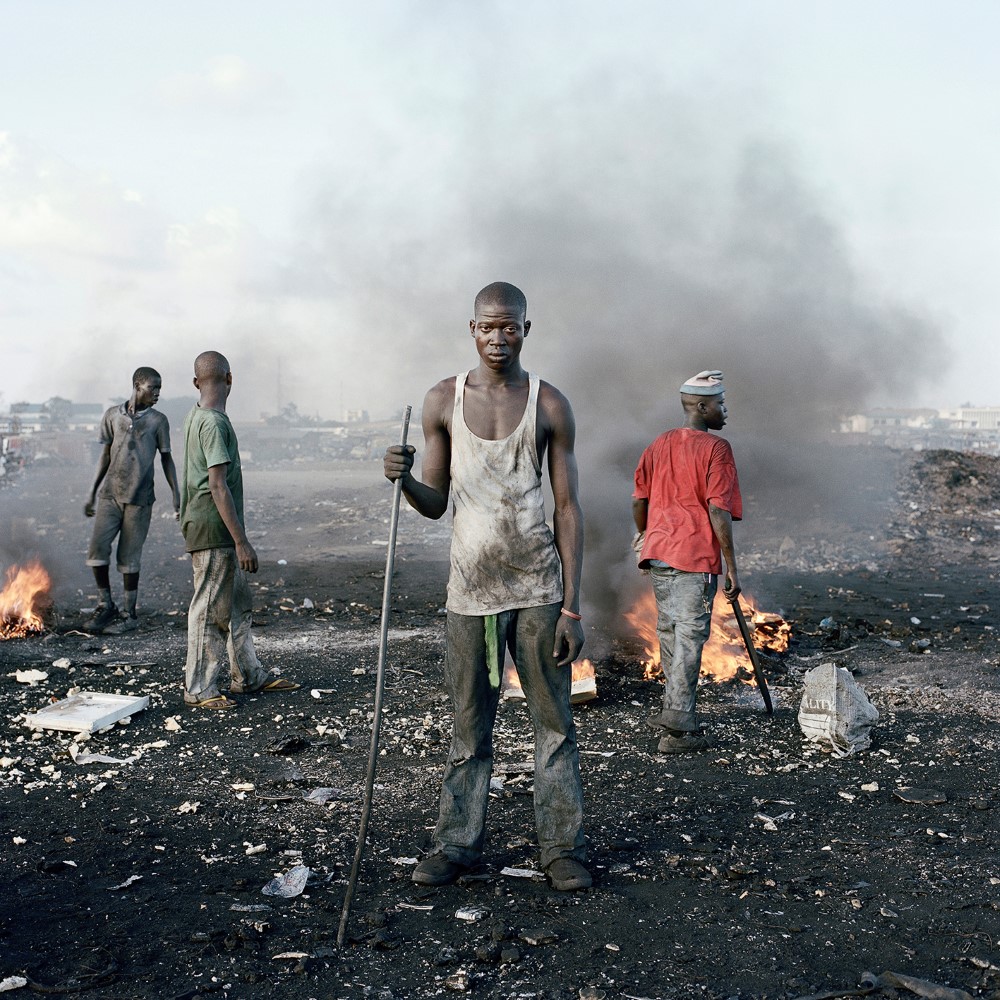
David Akore, Agbogbloshie Market, Accra, Ghana 2010
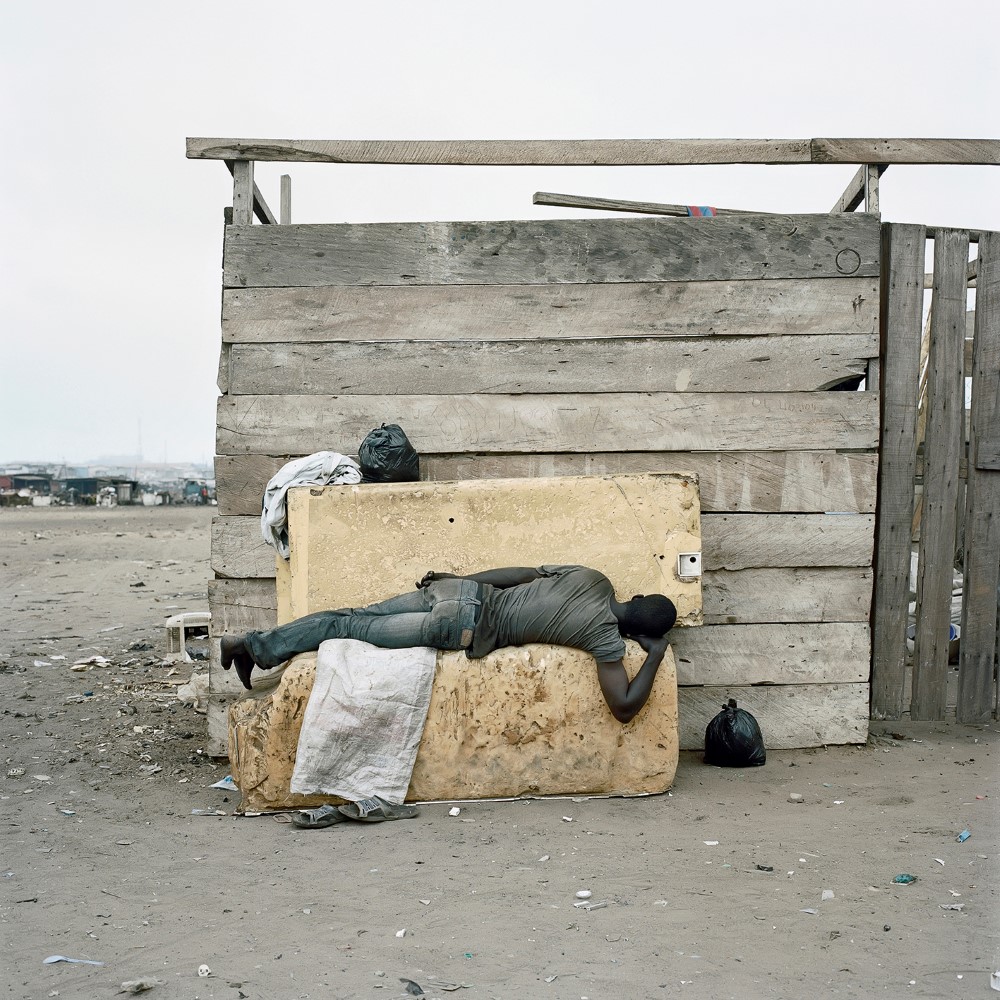
Agbogbloshie Market, Accra, Ghana 2010
“When I look at it, I actually see the future of the West. A near future that is a real possibility where we scavenge and survive in a burnt out world on top of technological dumps.”
MS: With much attention on the well documented economic developments within Africa, it still can be regarded in the West (particularly culturally), with the typical trope of the dark continent or this big slice of ‘otherness’. Or with a sort of watchful sneer, which you could argue is also received by the exported behaviour and ambition of Russia, China and even the Gulf States. I was always intrigued by the projects that you pursue, being much more what we could call liminal areas of ‘otherness’ within Africa. The fringes of a part of the world already not clearly within everyone’s consciousness. Those outsider groups. I think about The Hyena and Other Men or even the Nollywood project to an extent. What really drew you to the industry, or world of Nollywood?
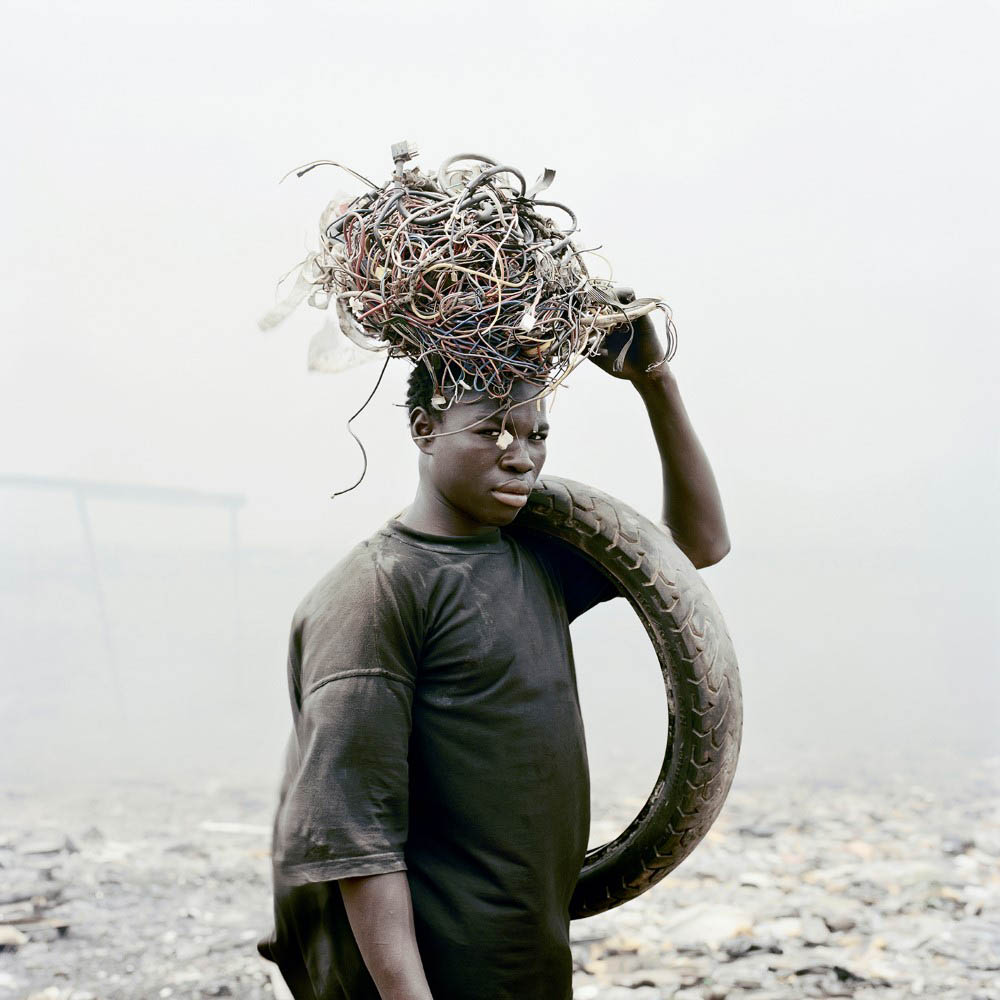
Yakubu Al Hasan, Agbogbloshie Market, Accra, Ghana 2009
PH: Nollywood came out of photographing the series of the Hyena men. Whilst working on that and some editorial jobs, I made a few trips to Nigeria between 2005 and 2007. Wherever I went, every bar, or hotel I spent time in, there would always be people coming in selling stacks of DVDs. Everywhere I went, I saw people watching these locally produced movies at full volume through a broken speaker and at first it really irritated me, because the production quality was so low. I just couldn’t understand how anyone could suspend their disbelief watching this. Of course the movies have come a long way since then, but at that time the production quality was make-shift, but then it suddenly dawned on me that this was really interesting as it is also real and authentic. It is not Hotel Rwanda made with French funding, with an American actor, shot in South Africa which is supposed to be Rwanda for a supposed ‘first world’ audience. So this got me thinking how does one approach this theme without photographing in a documentary way? Simultaneously I had some other preoccupations – I was becoming aware of how people were reading my imagery and the debates that have arisen from this. I go to this place, take pictures, then put the pictures up on a white wall in New York, changing the context. I was very aware of these problems. So one of the ideas I had was to photograph Nollywood actors but completely play with how the West wants to see Africa as this hyper-exotic space. Be a little tongue in cheek with the inevitable audience, but then of course Fuck! I failed because so many people read this work as an affirmation of those stereotypes. You can’t win!
MS: Recently I went to a talk by Nobel Laureate, Wole Soyinka, one of my favourite writers and within his lecture he used Nollywood as a conduit for escapism for Africans. He was interested in the myths that Nollywood creates, in a sense replacing the pre-colonial myths of old and working as a kind of placebo and a solid societal metaphor to the problematic politics of the country. Do you see any of that kind of escapism in Nollywood?
PH: Like Hollywood you’ll have Nollywood films that are purely escapist, but Nollywood films also take on day-to-day social issues, prostitution, corrupt politicians and so on. There are a number of things about Nollywood that I found interesting after the fact. The industry came about and evolved quickly because technology became much more affordable. The flip side of this event I later addressed in Permanent Error.
“I’m not interested in making work that sits only in a comfortable space, work that is purely decorative, so if my work strikes some nerves and irks some critics and creates a debate, then it has succeeded.”
This book was a very much a collaborative effort, I worked with the make up artist Gabazzini Zuo and he was involved in every picture. The book is dedicated to him and it also acts as portfolio for his work. Zina Saro-Wiwa – who became a good friend – wrote a great text for it, as did Chris Abani. They’re both writers whose credentials and commitment to Nigeria is impeccable, yet after working with me critics called them race traitors. I’m sure this was very traumatic for them. This is an interesting issue.
MS: Indeed. It does also for me beg the question that why did this work receive such a vitriolic response and not the work of say, someone like Cristina de Middel? Is this an interest point of reference here? Was your work and your position too far from a myth and too close to a reality?
PH: I think I can respond on two levels here, personally and philosophically. Personally of course it hurts. There is a lot of emotional and physical investment that one puts into a project of this scope and receiving that type of response definitely upsets and angers me, but then as an artist you have to step back and take stock of what your reasons are for making the work and where does it come from? If I think about the music I listen to, or the works of art I collect, or the books I read- it is all confrontational, it is all aimed at making my understanding of the world more profound. I’m not interested in making work that sits only in a comfortable space, work that is purely decorative, so if my work strikes some nerves and irks some critics and creates a debate, then it has succeeded. My understanding of imagery has naturally deepened over time and I’m aware of more nuances in my work. I understand that my images have their own power totally independent of me that created them and they launch interpretations and visual representations serving as conduits for newer understandings of things.
MS: Something I’ve been thinking about recently is ‘blackness’ as a commodity. Certainly a successful visual commodity when you look at its prevalence within our popular culture and beyond. even within the art world. I’ve been mulling over the disconnect between the full fat commodity of this ‘image’ and the paltry reality of its source. Who actually owns this image or commodity of blackness? I think we can see examples of the disparity between the two elements across the globe. There are also artists certainly making use of that commodity whether consciously or not, who may not acknowledge that this commodity immediately lends their work a kind of accessibility or indeed exoticism. I think of work I really like too like Lorenzo Vitturi’s Dalston Anatomy, though here I am just honing on one one aspect of it as an example, but I could cite many more.
PH: Hmm, you’re right. What makes Vutturi’s work really interesting is that there is a real engagement with the environment. In regards to de Middel, her work can not be seen as afro-pessimist, it is quite celebratory. Afronauts particularly has a cuteness to it. My work is much darker. perhaps I made a mistake entitling the work Nollywood. Maybe I should have made it clearer that there is an intervention here, but then I also think that is what gives the work its energy. I think of Roger Ballen’s Outland and Platteland work. I found it really interesting because it sat in a space where you couldn’t define what the fuck it was. Is this real? Is this constructed? Is this transgressive? I dont know. It was giving representation to something that didn’t yet exist.
MS: Similarly, I felt your Nollywood project inhabited a space, almost in a sense two steps removed from the source, you’ve almost added another layer of fantasy to an arena of fantasy.
Thinking about your subsequent work Permanent Error and the prolific use of smartphone technology across Africa for everything from communication to entertainment and in a way the continent seems to have leapfrogged laptop culture, it seems disposable technology is also a big area for discussion here. Where did the waste in those dumps you photographed in Permanent Error come from?
PH: Certainly in South Africa smartphones across all economic strata have taken hold and acts an empowering tool. The Permanent Error work in Ghana, shows this deluge of technological waste from the West, which is effectively getting recycled in Ghana. Recycled in a terrible way, using quite stone-age techniques like rock and fire, but the commodities such as copper and lead are being extracted and resold. Beyond moralising this dynamic – which is easy to do if we dwell on disparity between the ‘developed’ and ‘developing’ worlds and between the obvious geopolitical imbalances that find expression in a computer dump in West Africa – as much as these are portraits of young disenfranchised men and women, they are equally portraits of ourselves. We need to deal with this issue, we need to deal with ourselves, Something that hasn’t been addressed is this series is how futuristic the images are. When I look at it, I actually see the future of the West. A near future that is a real possibility where we scavenge and survive in a burnt out world on top of technological dumps. So to me the project isn’t Afro-Pessimism, it is a global pessimism, it is a warning. It is the sort of thing JG Ballard writes about.
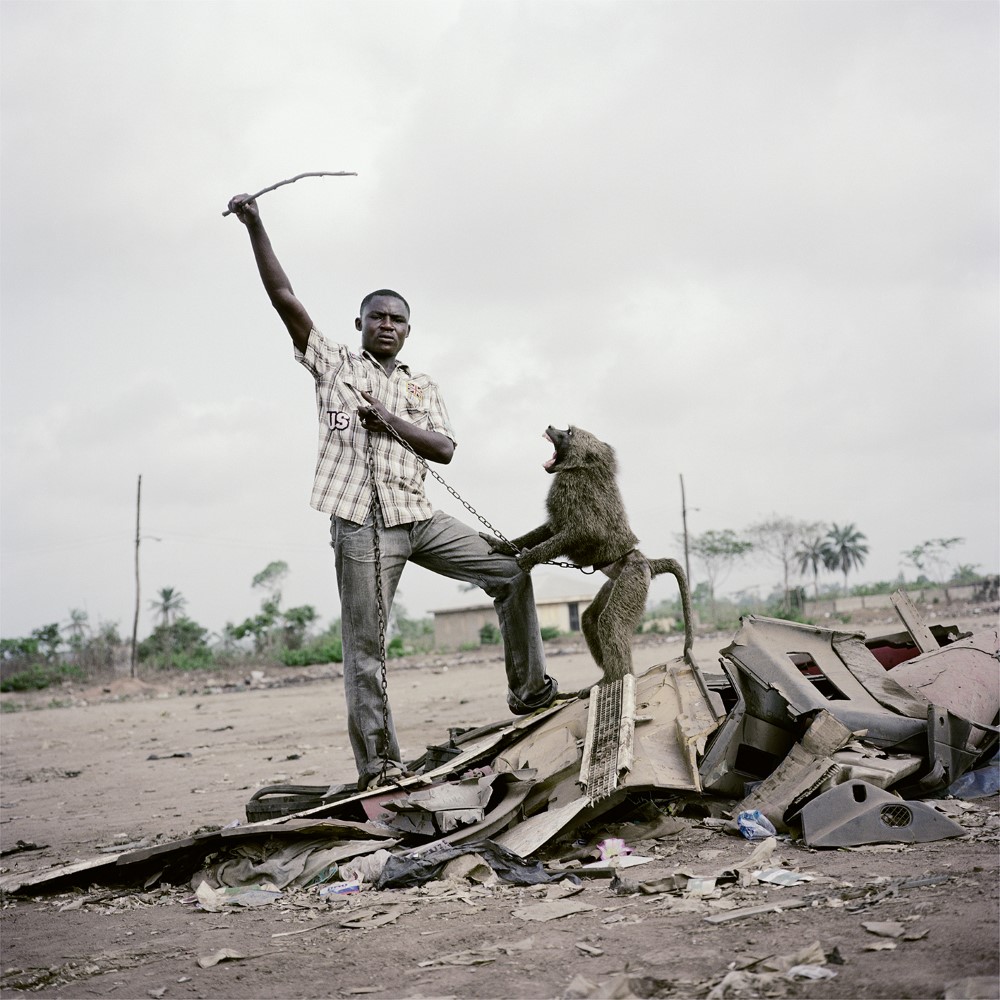
Alhaji Hassan with Ajasco, Ogere-Remo, Nigeria 2007
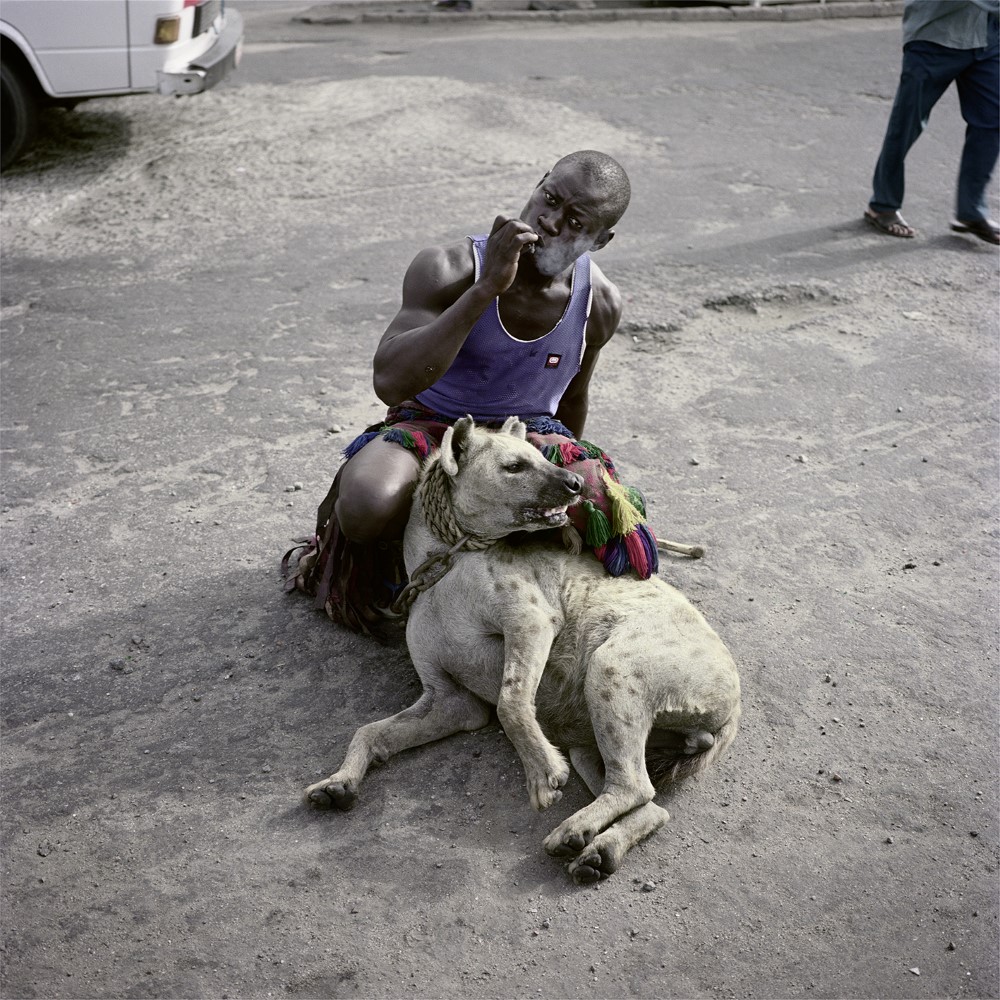
Abdullahi Mohammed with Mainasara, Lagos, Nigeria 2007
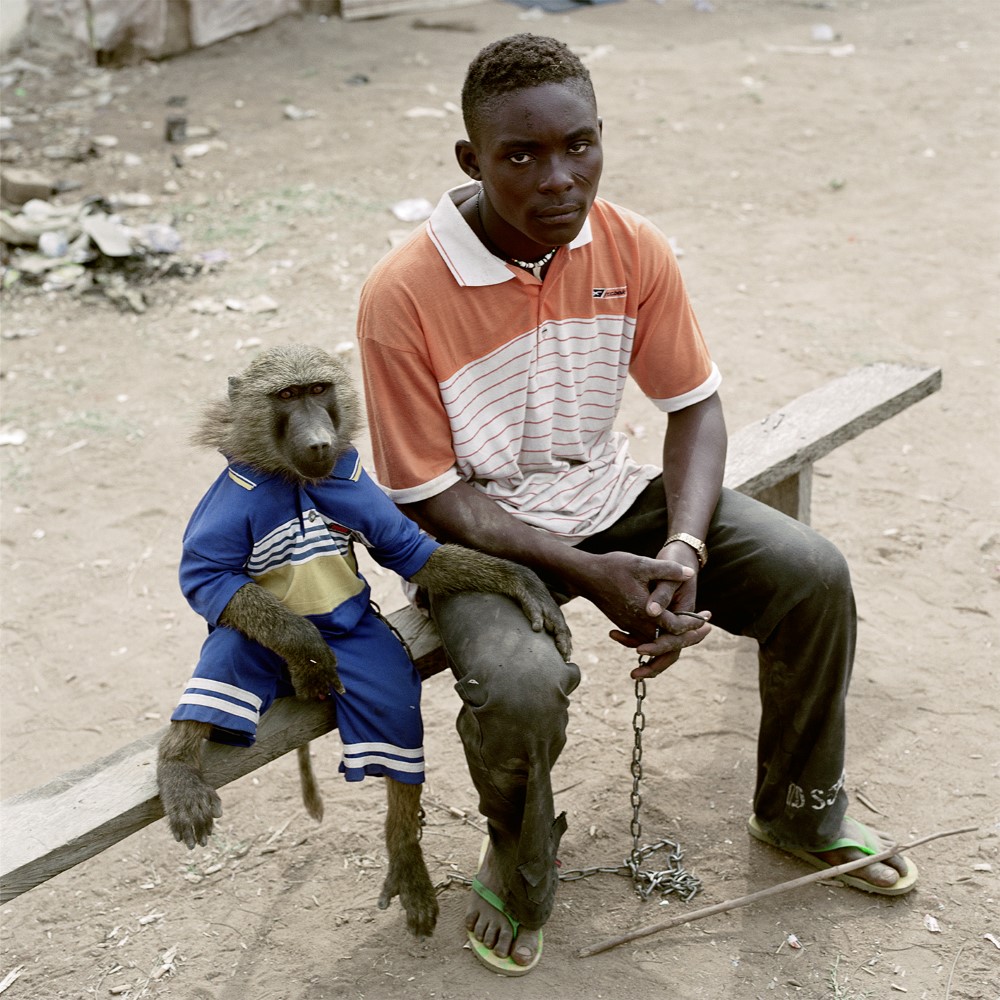
“It is not Hotel Rwanda made with French funding, with an American actor, shot in South Africa which is supposed to be Rwanda for a supposed ‘first world’ audience.”
MS: I saw it as part of a much wider discussion when we look at what many of our conflicts are founded upon and what we might argue is now a gradual shift in the balance of global economic power. In many ways Europe and the US are ageing, at least their traditional economic models are and we’re witnessing a global reaction to this now.
Given the kind of themes you’ve been tackling with your work, where do you see yourself going with photography?
PH: Over the last year I’ve been working in the USA, shooting the homeless in California, I’m still not sure what I’ll be doing with it yet. I’ve also been shooting a project in both Rwanda and South Africa and getting back into doing editorial work. I suddenly came to a realisation as an artist that I get a lot out of editorial work. Assignments force me to go out into the world. Mostly I don’t always like the results, but they force me to take chances. I never like the idea of sitting in a studio, trying to conjure the master project. I respond to my environment and that is what I like about photography, it straddles an interesting space between document and art which very few mediums can successfully play with. There was this period where it became unfashionable for photographers to do assignments and photographers had to become ‘artists’. That seems very dated now.
MS: I guess some of these assignments might then be catalysts for other work?
PH: They often are. I try to combine the two. Often assignment help me get access and funding for my own projects.
MS: I wondered how you felt about the greater emphasis we see on the use of photography as an art practice. It seems the way we chose to document more generally has changed because of the way we communicate with imagery now and the immediacy of platforms like Instagram. Do you think photographers are under pressure to created more reverence around their work?
PH: Interesting question. I don’t see curators necessarily trawling Instagram for the next great photographer, but I do think photographers are under pressure to create what you refer to as reverence and I think a lot of what is created at the moment is totally disingenuous. Photographic art made for curators. Work you can explain in a sentence or two. Here’s the concept and now we make the work. That said of course there are photographic artists that are absolutely wonderful. These things are cyclical. We’ve seen many of those periods during which Cindy Sherman goes in and out of fashion and back again! For a practitioner I think these cycles are good, because it separates the wheat from the chaff. If forces one to just knuckle down and make work. Artists are needy people who need constant affirmation. You need to learn how to deal with these cycles if you’re in it for the long haul!
MS: I guess you need to feel out an evolving core of strength to the progression of your work too, to withstand the changes and fluctuations in trends.
“I don’t see curators necessarily trawling Instagram for the next great photographer, but I do think photographers are under pressure to create what you refer to as reverence and I think a lot of what is created at the moment is totally disingenuous.”
I spend a lot of time with African writers and there is a constant grapple with just being able to be regarded as ‘writers’ rather than ‘African writers’. They wonder often why through their words, they’re obliged to adhere to an outmoded focus on economic or political issues because they’re circumstantially an ‘African writer’. Given the ‘outsider position’ you seem to have, is this something you’ve had to deal with during your career?
PH: I think my answer can only be a personal one. I don’t think being African means your writing needs to be political, but I do think my own works need to be political. That is because of my own history and the environment that shaped me. This comes back to the clichéd questions people often ask me; “What’s it like down in Africa?” or “What do you say to people when you take their portraits?” I mean fuck, I’ve shot a million portraits! It varies from person to person! Or “How do people react to your pictures?” You can’t generalise in that way, you just have to be honest with yourself and try not to buy into making work to please collectors or curators. Which is sometimes difficult to do, because you have to exist in their world at the end of the day!
MS: As possibly an interesting segue, I’d like to follow this with seeing whether you had any thoughts on the furore that South African artist and theatre director Brett Bailey’s recent work has caused in a number of countries. I’ll quickly explain, his project which is entitled Exhibit B is a recreation of human zoos that were quite popular in parts of the world during a pretty recent history. So Bailey has recreated these scenarios, almost faithfully with black actors and performers from a variety of backgrounds. This work has been hugely controversial around the world, but also critically acclaimed. Bailey has been unable to show this work in a number of places, including the Barbican in London. An online petition was started by a self-referential ‘black community’ in London, receiving thousands of signatures and a subsequent protest was organised for the opening night, leading the Barbican to cancel the entire series of shows. The organisers of the petition and protest hadn’t actually seen the work, neither had the majority that proffered their signature, but they all took umbrage with the very idea of the work. A part of the argument was why should Brett Bailey, as a ‘privileged’ white South African, be able to exercise such an opinion or make such an observation through this kind of work, which is in part a more global comment on the industry of slavery as a very current feature of our economy and ultimately humanity. I had written a text about this partly arguing, well, why not? How could you say that Bailey’s own history isn’t intertwined with the history of slavery and why wouldn’t he try to understand the machinations of this? Doesn’t the legacy of slavery and oppression also belong to him too?
PH: Or the guilt that he has?
MS: Absolutely.
PH: I totally agree with you and I think the Barbican, by shutting down the show handled it very, very badly. Surely the curator should have taken a position and opened some sort of forum for a discussion about it. Instead of avoiding the issue, take it head on, bring everyone to the table and discuss it. It seems to me the real shortcoming here is a curatorial one.
MS : Yes, it was handled poorly, but I think I was personally also quite upset by the way the general public responded with a blanket lack of any critical engagement with the work, yet many were so vehement that their reaction was just. I understand why that reaction was what it was, it is difficult to look at something we still carry.
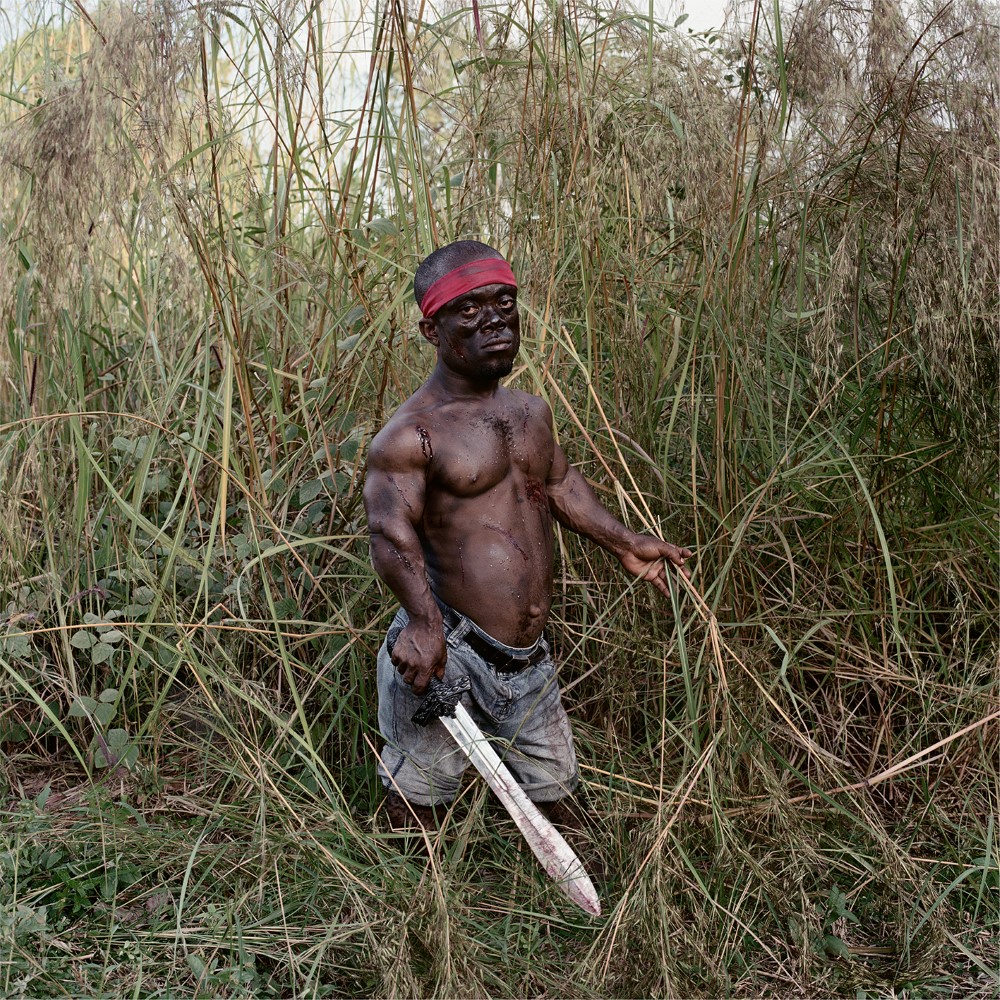
Omo Omeonu, Enugu, Nigeria, 2008
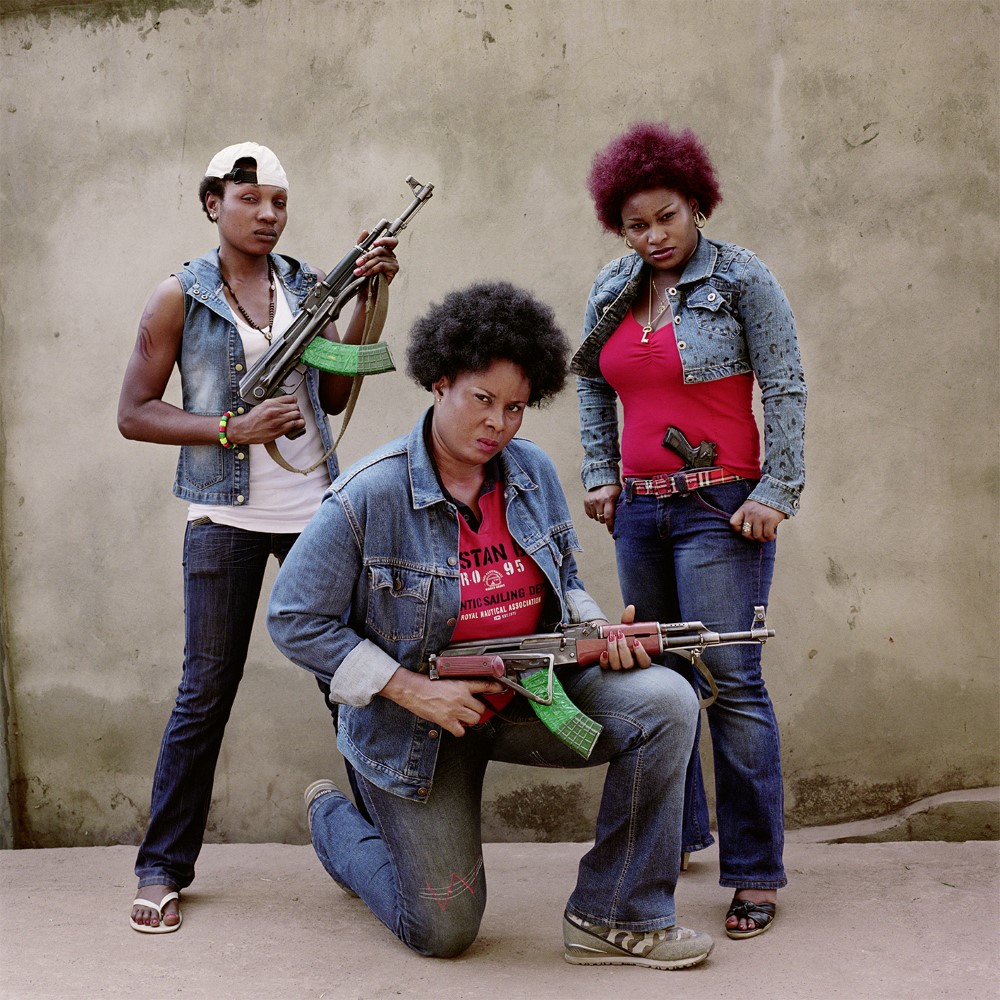
Chommy Choko Eli, Florence Owanta, Kelechi Anwuacha. Enugu, Nigeria, 2008
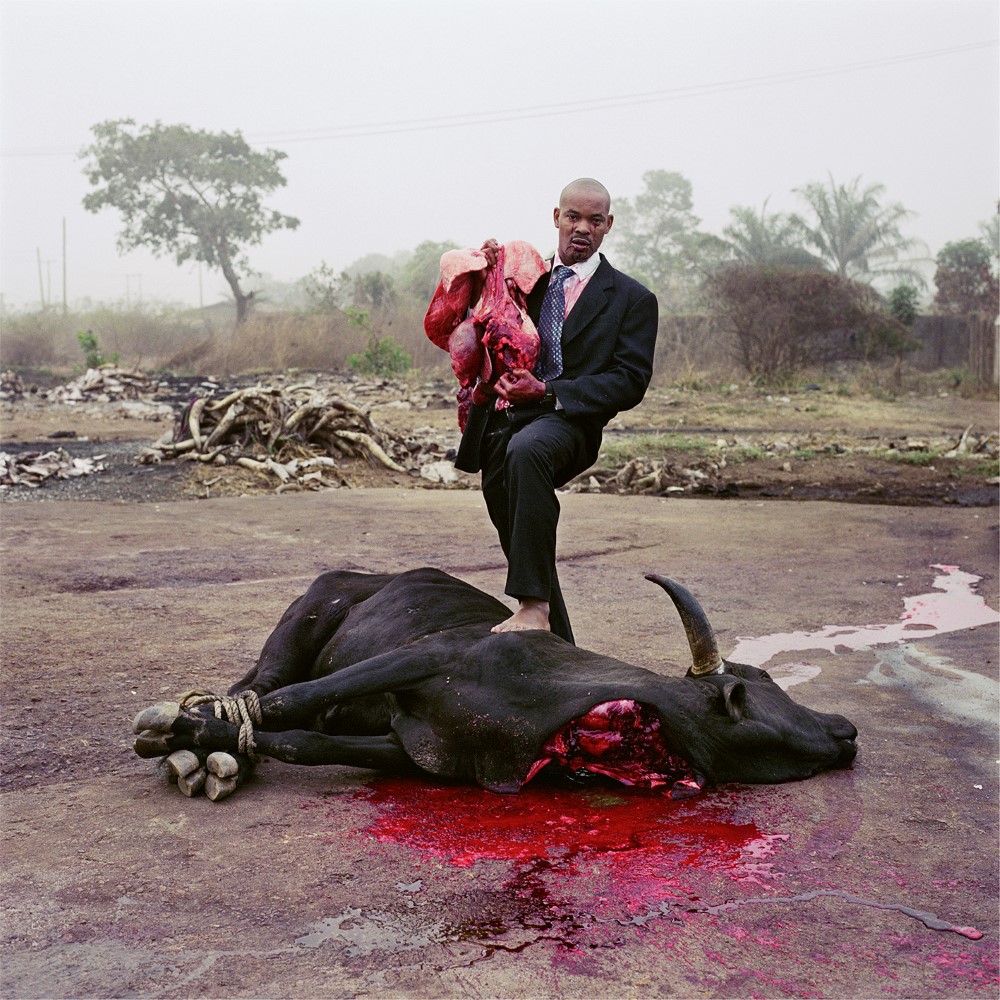
Gabazzini Zuo. Enugu, Nigeria, 2008
“Who actually owns this image or commodity of blackness?”
PH: People are hurt historically, they’re deep wounds.
I think Jeff Wall once said this, ‘the great thing about art is that it causes change’. Not necessarily the change you intended, but for instance Brett Bailey’s art has crystallised opinion that you cannot show this kind of work or have a discourse around this kind of work and that does show you the power of art. It saddens me very much.
Brett Bailey is an incredibly complicated human being, his work is deeply problematic and that is why it is great and it certainly gets us talking. What is really a shame is that Brett has actually built this family of artists around him. He has a family of creative collaborators. They work together regularly. Do you know Brett?
MS: Well, not closely but we got talking recently because of the Exhibit B project. The Barbican had sent me to see it in Paris and write a report, which I turned into an essay and sent it on to Brett to see what he thought.
PH: He’s an interesting guy. He often works with the same actors and has been doing it for a long time now. He is really invested in what he does. I think he deserves a bit more respect for his work. He isn’t just a shock artist. Unfortunately I haven’t seen the show, but would love to. What’s it like?
MS: I found it to be actually very subtle and nuanced, beneath this immediate viscera you’re faced with. The most powerful thing about the work was what happens the moment you enter the space. You must confront yourself, whatever your race or disposition, as soon as you enter the show and are confronted by someone looking directly back at you from inside a cage, or shackled and bound, or performing on a plinth and I don’t think I’ve ever experienced that in an exhibition before. What the actors do really well here is sustain an unflinching stare in their forced insentience, cold and weary eye contact tracking yours until you can only look away. So you can imagine how that feels as you move around the exhibition. Two hundred years ago, you may have been told that this person is a lesser form of being than yourself. But then you’re challenged by this idea as soon as you make eye contact with this ‘other’ person and there is a transference that happens, and that for me was the power in Bailey’s work.
“Photographic art made for curators. Work you can explain in a sentence or two. Here’s the concept and now we make the work. “
PH: I think thats very interesting, that is something I definitely look for when I make portraits. I want that desire to look requited. As hard as you look, I want to be looked back at. Portraits that hold you and won’t let you go.
We live in an era where artists constantly have to self censor. In my experience more often to pander to a disingenuous idea of political correctness than to conservatism. I won’t do that and feel sympathy for Brett. It makes me think of that Dead Kennedy’s song “…It’s the suede/denim secret police, They have come for your uncool niece…”
MS: Yes, the community that historically and still deal with this oppression, seemed to begin taking on a kind of supremacist rhetoric and that kind of censorship I found to be really problematic. If you don’t engage with a work of art (and principally that is all we’re dealing with here), then there is a dangerous precedent being set.
PH: Yeah, I think this argument ends with the fact that the people who are protesting Brett’s work didn’t see the show. It is like banning books without ever having read them.
Michael Salu is a writer, art editor and creative director. He’s also a Director at American Suburb X.
EXPLORE ALL PIETER HUGO ON ASX
Connect to the ASX universe! Like us on Facebook, follow us on Twitter and Instagram.
(All rights reserved. Text @ Michael Salu. Images @ Pieter Hugo and courtesy Yossi Milo Gallery New York and Stevenson Gallery Cape Town.)













